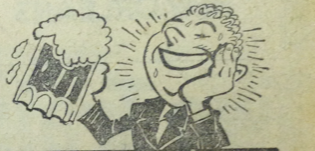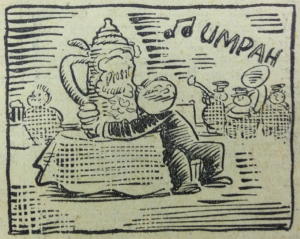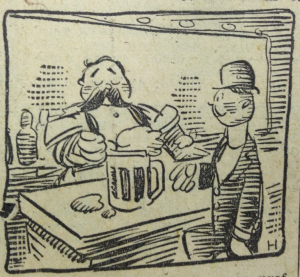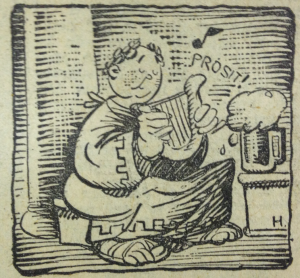When beer became legal in New Orleans on April 13, 1933 after thirteen years of living an outlaw existence, the New Orleans States ran an article to instruct beer-loving consumers on proper beer lingo.
Forgotten Words Are Back With New Beer
Many strange words we heard in New Orleans Thursday, words which have been forgotten for 13 years. Millions of young Americans never heard some of them at all.
So, for the benefit, and the possible enjoyment of those who know but have forgotten them, the following glossary of words used in connection with the drinking of beer is presented:
Blind Robins – Small salty fish used by free-lunch dispenser to whet the thirst of customers.
Bock – Literally “Goat” the spring beer, first product of the winter vats at Easter time.
Boot – A formidable glass container in the shape of a boot, drained by grasping it at the ankle.
Bung Starter – The heavy wooden mallet with which dispensers of an earlier and more robust day smashed into the bung or wooden “cork” of a beer keg, The bung starter also made an excellent weapon or “persuader.”
Can – See Growler.
Chaser – A small draught of beer sometimes used to put out the fire kindled by something illegal.
Collar – The band of foam that forms on the top of a glass or mug of beer.
Gesundheit – Toast. “Health.”
Growler – A small tin bucket for “rushing” draft beer from the place of sale to the place of consumption.
Half and Half – A mixture in that proportion of lager beer and heavier beer or porter.
Handle – Nickname for a seidel of beer, from the handle you pick it up with.
Hell – German for “light,” the only kind of beer you’ll get. You probably won’t have to worry about “dunkel” which means “dark.”
Hoch – German toast. Literally “High.”
Kapellmesiter – Leader of “Dot little Chermanband.”
Lager – Light, aged beer, the kind you’re going to get.
Liter – European unit of liquid measure, just over a U.S. quart (1.05 quarts). Most beer mugs, seidels, steins hold up an even number of liters.
“One Up” – Or “two up,” or three or four. The classic order of the waiter to the dispenser to indicate the number of beers to be drawn.
Pony – A small keg, containing a quarter of a full barrel.
Prosit – Common beer toast. Really Latin, meaning “may it do you good,” but adopted by German students and thoroughly domesticated by them.
Rathskeller – Literally, the cellar of the town hall. Any large room preferably decorated in German style, where beer, food and music are featured.
Schooper – Also Schupper, and even Schoofer. Loosely used term for a container of beer, applied to all the usual steins, mugs, etc., but properly the small glass stein.
Seidel – The beer mug with the hinged top which helps keeps the beer from going flat.
Shell – The small straight-sided light glass which will probably be the most common container of the new beer.
Skoat – Scandinavian toast, “Hall.”
Snit – A diminutive straight-sided glass holding up as much as an eye-cup.
Stube – See Rathskeller, but usually smaller and more intimate.
Suds – Beer itself.
Swipe – The light paddle, of horn, bone or celluloid with which the bartender deftly removes excess foam from the top of the glass.
Tulip – A tall tapering glass with a short stem; once favored by feminine beer drinkers.




